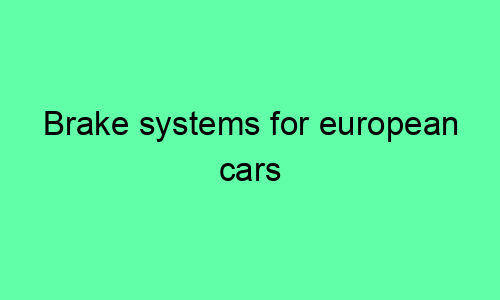## Brake Systems for European Cars
### Introduction
European cars are renowned for their performance and handling, and their brake systems are a key part of that equation. European brake systems are typically designed to provide excellent stopping power and modulation, while also being durable and reliable. In this article, we’ll take a closer look at the different types of brake systems used on European cars, and we’ll discuss the advantages and disadvantages of each type.
### Types of Brake Systems
There are two main types of brake systems used on European cars: disc brakes and drum brakes.
**Disc brakes** are the most common type of brake system used on European cars. Disc brakes consist of a rotating disc that is mounted to the wheel hub. When the brake pedal is applied, hydraulic pressure is sent to a caliper that squeezes the brake pads against the disc. This friction causes the wheel to slow down or stop.
**Drum brakes** are less common than disc brakes, but they are still used on some European cars, particularly older models. Drum brakes consist of a drum that is mounted to the wheel hub. When the brake pedal is applied, hydraulic pressure is sent to a wheel cylinder that forces the brake shoes against the inside of the drum. This friction causes the wheel to slow down or stop.
### Advantages and Disadvantages of Disc Brakes
**Disc brakes offer several advantages over drum brakes, including:**
* **Better stopping power:** Disc brakes provide better stopping power than drum brakes because they create more friction between the brake pads and the disc.
* **More consistent stopping power:** Disc brakes provide more consistent stopping power than drum brakes because they are less affected by heat and fade.
* **Longer lifespan:** Disc brakes typically have a longer lifespan than drum brakes because the pads are easier to replace.
**However, disc brakes also have some disadvantages, including:**
* **More expensive:** Disc brakes are more expensive to manufacture than drum brakes.
* **More complex:** Disc brakes are more complex to install and maintain than drum brakes.
### Advantages and Disadvantages of Drum Brakes
**Drum brakes offer several advantages over disc brakes, including:**
* **Less expensive:** Drum brakes are less expensive to manufacture than disc brakes.
* **Simpler:** Drum brakes are simpler to install and maintain than disc brakes.
**However, drum brakes also have some disadvantages, including:**
* **Less stopping power:** Drum brakes provide less stopping power than disc brakes because they create less friction between the brake shoes and the drum.
* **Less consistent stopping power:** Drum brakes provide less consistent stopping power than disc brakes because they are more affected by heat and fade.
* **Shorter lifespan:** Drum brakes typically have a shorter lifespan than disc brakes because the shoes are more difficult to replace.
### Which Type of Brake System is Right for You?
The type of brake system that is right for you depends on your individual needs and preferences. If you need the best possible stopping power and modulation, then disc brakes are the way to go. However, if you are on a budget or if you are looking for a simpler brake system to maintain, then drum brakes may be a better option.
### Conclusion
The brake system is one of the most important safety features on your car. It is important to understand the different types of brake systems available and to choose the one that is right for your needs. If you have any questions about your brake system, be sure to consult with a qualified mechanic.






